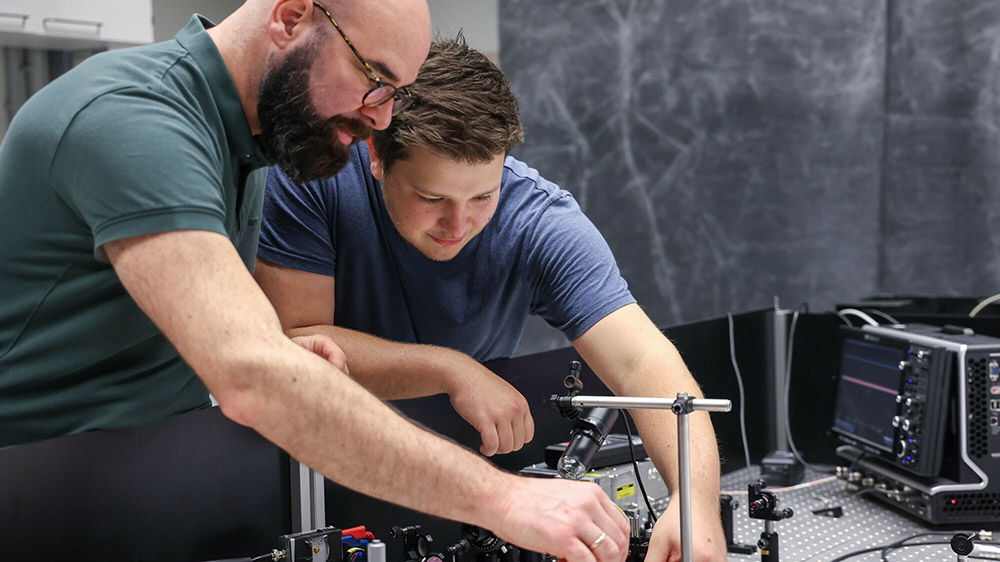TXproducts

Business idea: Ultra-precise selection for highly complex experiments on synchrotrons
Industry: Experimental
Year founded: 2021
The founders of TXproducts are developing a device at DESY that will make many synchrotron experiments much faster and cheaper
Category
On this page
TXproducts: WaveGate accelerates experiments and reduces costs
Light travels a distance seven times around the equator in one second. With its business idea WaveGate, the start-up TXproducts, founded in April 2021, can switch an X-ray beam on and off so quickly that its light travels only 30 metres in this time. Such ultra-precise selection can be extremely important for the highly complex experiments on synchrotrons. With the help of start-up advice from “beyourpilot” (Editor’s note: “beyourpilot” has been operating under the “Startup Port” brand since July 2023) and funding from the “Investitions- und Förderbank Hamburg (ifb)”, a demonstrator is to be fully developed by February 2022. First sales are planned for 2023.


Is the Rembrandt painting an original or a fake? How do the active substances in a tissue sample react with the body cells? How do superconductors and other electronic components behave under different conditions? A synchrotron can help with these tricky questions: this is a huge particle accelerator facility that produces high-energy X-rays. This is directed to several experimental stations, so-called beamlines, to expose material samples. In this way, scientists from research and industry can investigate many different structures and processes at the molecular level. The measurements can be used to optimise computer chips, recognise the structures of viruses and specifically develop new medicines.
The catch is that synchrotron radiation sources always provide their enormously bright, pulsed X-ray beam at a defined strength and pulse frequency for a certain period of time, which is often not suitable for each of the 30 or even 40 connected experiments. Therefore, the researchers at the stations either have to work with filters and switches to modulate the beam. Or they have to wait for a certain beam time of the large-scale facility that suits their needs. Their project can thus be delayed by weeks or even months. So it is much better to adjust the beam. “There are already good solutions for the energy and size of the beam,” Dr Peter Gaal , one of the two founders of TXproducts, tells us. “But not for the time structure.”
The business idea: WaveGate is faster than the X-ray flash
This is exactly where TXproducts comes in with WaveGate, this small box can be easily interposed in a beamline and enables the time structure of the X-ray beam to be adjusted to the respective experiment. The most important element of WaveGate are the lithium niobate crystals. These are piezoelectric crystals that can be found as signal filters in every modern mobile phone, but also in sensors for detecting viruses, for example. Such crystals generate an electrical voltage when they deform and can be deformed in a targeted manner by applying an electrical voltage to them.
Now, when the X-ray beam hits the surface of the crystal with a frequency of, for example, one pulse every 200 nanoseconds, the switch can emit a high-frequency electrical signal that the crystal receives with tiny antenna-shaped structures that TXproducts has applied to its surface and converts into surface sound waves. The same kind of sound waves are also generated by earthquakes. The switch therefore triggers a kind of earthquake on the crystal, which changes the lattice structure of the crystal. With this changed surface structure, the X-ray beam is now reflected at a different angle. “So with WaveGate we can control the diffraction of the X-ray beam and thus select certain pulses of the beam and sort out the others,” explains the second TXproducts founder Daniel Schmidt. “For example, if I don’t need the pulse every 200 nanoseconds, but only one per millisecond.” To give an idea of how fast the switch works, a comparison: light travels a distance seven times around the equator in one second. WaveGate can switch the X-ray beam on and off so quickly that the light only travels 30 metres in that time.
WaveGate is as variable as a Swiss army knife
Such ultra-precise selection can be extremely important for the highly complex experiments on synchrotrons. For many samples, too much radiation is harmful; they can only withstand a few pulses and otherwise decay. “Some processes that I want to observe also only last as long as a single pulse,” says Schmidt. “So for that I have to isolate a single one and can’t use any more at all.” So with WaveGate, you can dose both the amount of incident X-ray light and the frequency of its pulses at the beamline. And it is as variable as a Swiss army knife: the switch allows different settings and can be used for different experiments. Above all, this is where it differs from previous solutions. Conventional optics for adjusting the time structure are usually rigid and can therefore only be used for one type of experiment. Moreover, they are significantly more expensive than WaveGate.
WaveGate speeds up experiments and reduces costs
With WaveGate, many synchrotron experiments can be carried out much faster and cheaper. “Work that used to take an hour and cost 1000 euros can now be done in half a minute for 10 euros,” says Peter Gaal. This benefits not only the researchers themselves, but also the operators of the synchrotron, as they can better utilise their beamlines. Gaal estimates that about 30 per cent of the experiments at synchrotrons benefit from this. Some even become possible at all as a result.
Peter Gaal had the idea for WaveGate for quite some time. He is a scientist at the Leibniz Institute for Crystal Growth (IKZ) in Berlin, where he heads the X-ray optics working group. In principle, the IKZ and DESY complement each other ideally: at the IKZ, crystals are developed that are needed for research at a synchrotron like the one DESY operates with PETRA III. Conversely, the research at DESY provides answers to the question of how crystal growth can be improved. That is why the IKZ recently founded a JointLab with the Hamburg research centre on the DESY campus to intensify the cooperation. A device like WaveGate can therefore have a lubricating effect on cooperation.
Partner search for joint progress
“However, at first I had too little time besides teaching and research to pursue the idea further,” Gaal recalls. “I needed a partner. He found one in Daniel Schmidt. He was a student in Gaal’s research group, which he led as a substitute professor at the University of Hamburg. “Daniel brought everything we needed for our project: He is a specialist in nano research and temporally high-resolution X-ray and laser technology – but above all, he has the necessary drive and ambition to really push something like this forward.”
Synergy effects with the DESY Start-up Office and beyourpilot
By locating in DESY’s Innovation Village, the two benefit from many synergy effects: For one thing, there are beamline researchers at DESY’s PETRA III X-ray radiation source who are just waiting for WaveGate to be ready so they can use it. “They will be our first customers, accompany our development and enable us to test the device without having to apply for beam time every time,” explains Daniel Schmidt. With regard to their start-up, the two scientists are accompanied by the “DESY Start-up Office” as well as “beyourpilot” (Editor’s note: “beyourpilot” has been operating under the “Startup Port” brand since July 2023): Start-up advisor Dr. Christina Frehse is assisting them with various questions. “It was actually the Office that made us decide to found our start-up in the first place,” Gaal notes. In addition, he and Gaal can exchange ideas with other founders on campus and find suitable new employees.
Over 50 synchotrons worldwide could benefit from WaveGate
The need for WaveGate is obvious: There are more than 50 synchrotrons worldwide, each with several beamlines connected to it. The gain in flexibility and efficiency for their work should convince many operators and beamline researchers. When the demonstrator is ready, its two developers plan to visit synchrotrons around the world to showcase their new technology. First sales are planned for 2023.
But that is not all. Gaal and Schmidt have long been tinkering with other switching devices. The next step will be to add “PicoSwitch” to the enormous speed of WaveGate. Using the analogy of a beam of light that races around the earth seven times in one second, PicoSwitch switches the light on and off within the width of a pin. That is five to ten picoseconds (trillionths of a second). This will even enable researchers to study processes that occur faster than the length of one of the X-ray pulses itself – for example, how the molecules in the retina of an eye deform when light falls on them. There is also a great need for this in modern research with X-rays and laser radiation. The other product that TXproducts is planning is to be called “NanoGate”. It will function similarly to WaveGate, but will be applicable to other light spectra.
The six-figure price of the small devices is to be considered relative. Especially since in the end, despite their modular design, each one will be unique: “We adapt each switching optic individually to the customer’s wishes,” says Daniel Schmidt. “For example, some need one that works in a vacuum – others don’t.” In modern high-tech research on synchrotrons, which cost billions to build and tens of millions a year to operate, such an amount is manageable – especially since it saves money again with each subsequent experiment.